The History of my Ham Life
I've always liked science since I was in elementary school, and I saw my father making tube radios and audio amplifiers. When I entered junior high school, there was a radio club, so I entered immediately. The adviser of the club was JA3AJ, who taught us not only the basics of radio, but also the fun of making things. It was around this time that we all made radios and audio amplifiers, and also learned Morse code. I didn't get a license for amateur radio at that moment, but I was able to get to know the fun of radio communication by communicating with a 27 MHz citizen band transceiver in the club. Also, around this time, I listened to overseas broadcasting stations on 5 tubes super-heterodyne radio, I was addicted to so-called BCL, and when I heard these overseas stations, I sent a report and collected verification cards and thought about distant overseas countries. It may be one of the motivations that made me interested in overseas.
Opening the Station
As soon as I entered the university, I got a radio license and opened the JA3RTU station at my home in Kyoto in 1968. Of course, the radio at the time was not as modern as it is today. My first SSB transmitter was a second-hand, Yaesu FL100B, and most of the circuitry consisted of vacuum tubes. This radio is extremely sturdy and withstands continuous use well, but the VFO is not stable. I tried to keep the power on about 30 minutes before the operation, but I was still troubled by QRH. The receiver was a trio (now Kenwood) 9R59D that was purchased and assembled with a kit. The VFO variable condenser is not a gear driven, but moved by string.In the high band above 14MHz, the sensitivity was insufficient and the stability was poor, so I connected a crystal converter. So the receiver was working as a triple conversion.
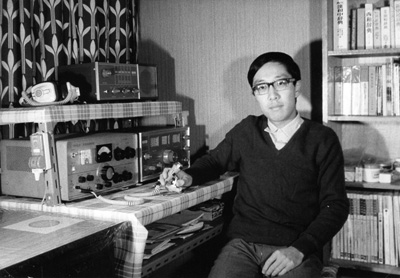
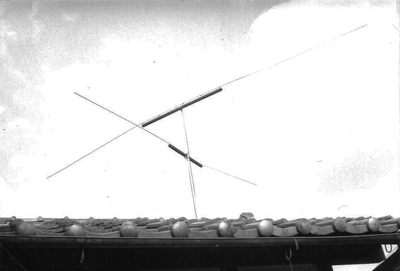
My first antenna was a homebrew rotary dipole made from aluminum pipe and wood. Since the directivity is a figure-8 shape, I was able to communicate with it
usually fixed, but in order to communicate with stations on the side of the element direction, I had to go outside my house and rotate the antenna. In 1970, I got a second class
license and can operate at 14 MHz. At that opportunity, I purchased three elements, 14, 21, and 28 MHz triband Yagi-Uda antenna called AS-33 made by Asahi Steel Co.
At that moment, I was a poor student, so I had no choice but to use other new rigs.
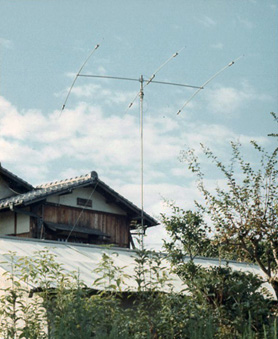 At the time of opening my station, it was around the maximum value of the sunspot number of the 20th solar cycle, and the propagation of short wave band higher than 14 MHz was very good,
and it was my big excitement when my voice can reach the other side of the earth even with a poorly crafted antenna. I didn't think I could speak English when I tried to speak with
foreign stations, so at first I was very shy. After installing the beam antenna, stable communication became possible, I started to schmooze in English especially with American hams.
One of them even recommended me to the Rag Chewers' Club. Now, thanks to amateur radio, for I can speak English moderately. I belonged to the Kyoto DX Club (JA3ZDX), a group that enjoys communication with foreign countries, founded by my old teacher, JA3AJ and others. It was my great pleasure and good experience to spend with veterans who are much older than me. I enjoyed various things, such as going to the sea and having banquets, as well as wireless communication. I also enjoy to welcome ham operators who visited Kyoto from overseas.
At the time of opening my station, it was around the maximum value of the sunspot number of the 20th solar cycle, and the propagation of short wave band higher than 14 MHz was very good,
and it was my big excitement when my voice can reach the other side of the earth even with a poorly crafted antenna. I didn't think I could speak English when I tried to speak with
foreign stations, so at first I was very shy. After installing the beam antenna, stable communication became possible, I started to schmooze in English especially with American hams.
One of them even recommended me to the Rag Chewers' Club. Now, thanks to amateur radio, for I can speak English moderately. I belonged to the Kyoto DX Club (JA3ZDX), a group that enjoys communication with foreign countries, founded by my old teacher, JA3AJ and others. It was my great pleasure and good experience to spend with veterans who are much older than me. I enjoyed various things, such as going to the sea and having banquets, as well as wireless communication. I also enjoy to welcome ham operators who visited Kyoto from overseas.
After that, I decided to study abroad in France in 1974, and returned to Japan in 1976, but since I was busy for my job, I almost stopped operating my station after that.
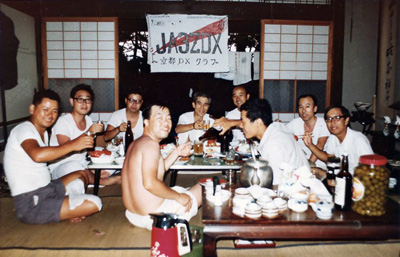
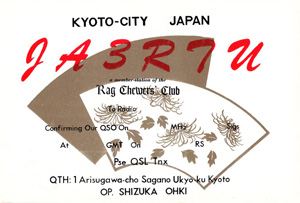
And reopen the station !
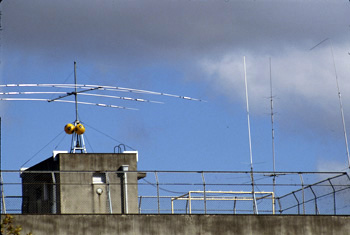
In 1985, I decided to open the station again in Fukui City, where I had moved in 1982. However, during the long QRT, the world of amateur radio has changed dramatically.
I was especially amazed at the small radios that were consisted of semiconductors completely and were controlled by a microprocessor. I also very surprised that the automatic
antenna tuner that was once loaded on the aircrafts introduced in CQ magazine of 1970's was available very easily. At that time, I lived in a government building and
was a so-called 'Apa-man' ham, so I couldn't set up a big antenna. I purchased Yaesu's FT757GX. I loaded this transceiver into my car to open a mobile station on the
short-wave band (HF band). Operating a mobile station on the HF band has been my big dream since I saw JA3AJ, a high school teacher, did DX QSO from a car.
From the time when I restarted my ham life around 1990, the solar cycle again reached the maximum sunspot number of cycle 22. I Obtained permission to set up a
shortened 14-21-28 MHz 3-element Yagi-Uda beam antenna on the government building where I lived, the radio communication around the world became much easier.
I could actually meet the people that I have met through radio communication when I visited these countries and I am now able to enjoy the real pleasure of this hobby.
These experiences are also on this website.
Since the 1990s, the application of digital technology and the use of computers have dramatically advanced in the field of amateur radio. Slow Scan TV (SSTV),
which digitizes still images and sends them via shortwave radio, and computerized digitized text communication like packet radio, Amtor, RTTY, etc are also available easily.
In Japan, connection between amateur radio and public communication lines has become accepted legally now. Depending on this new communication technique, long-distance
communication using internet network makes now very easy talking with long-distant stations including overseas. I am also operating EchoLink that uses VoIP developed in the
United States and D-Star that was developed in Japan and is now developing all over the world. For such new technologies are also introduced on this homepage.
